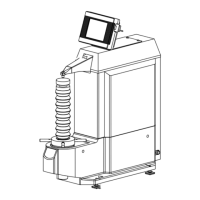No. 99MBG518A
A-14
PART A : 4 Hardness Test Methods
4.3
Plastic Hardness Test
4.3.1 About the Plastic Hardness Test
The plastic test is to obtain the hardness using steel ball indenter, applying a constant load to the testing
surface, applying a test load, and then returning to the standard load.
HR = 130 - e
HR:
Rockwell hardness
e:
Indent depth after unloading the test load indicated per 0.002 mm
4.3.2 Precautions for the Plastic Hardness Test
■Specimens
Useaspecimenthathasatsurface6mmthickormoreandanarealargeenoughtoperformatleast
vemeasurements.
Or, if a specimen as described above is not available, use a stack of specimens that have the same
thickness and that are made of the same material. Make sure that the surfaces of the specimens are in
completecontactandthatthestackedspecimensarenotseparatedduetosomesurfacedeciency.
■Distance to the edge of the specimen from the center of the indent
Performmeasurementsvetimesonthesamesurfaceofthespecimen.Useaspecimenthatmeetsthe
following conditions.
y Separate the center of the indent 10 mm or more from the edge of the specimen.
y Use a space 10 mm or more between any two measuring points.
4.3.3 Test Force (Plastic Hardness Test)
Rockwell hardness scale
Standard load Test load
Diameter of steel
ball indenter
N N mm
R 98.07 588.4 ø12.7
L 98.07 588.4 ø6.35
M 98.07 980.7 ø6.35
E 98.07 980.7 ø3.175
K 98.07 1471 ø3.175
Theseexplanationsareprovidedbasedonthedescriptionsof"JISK7202andASTMD785Plastics−
Determination of hardness".
For details, see
"JISK7202andASTMD785Plastics−Determinationofhardness".

